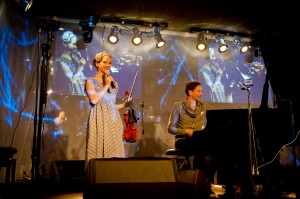By Rebecca Schmid
Richard Strauss was a man of many masks, from his intimate piano songs to the demonic outpourings of his stage works and tone poems. Following a semi-staging of his second opera, Feuersnot, in Dresden, where it premiered in 1901, the Gewandhausorchester Leipzig came to the Saxon capital on June 9 to stake its own claim to the early Straussino.
From the opening chords of the overture to W.A. Mozart’s Idomeneo, Riccardo Chailly and the musicians made clear that the morning program at the Semperoper would not easily fade from the audience’s memory. Incisive attacks, fleet but sumptuous bowing and vibrant dynamic contrasts created a sense of excitement and pathos.
In Brahms’ Serenade Nr. 2, a chamber work dedicated the Clara Schumann, Chailly shaped every phrase lovingly, creating a buoyancy that counteracted the music’s ponderous nature. The understated passion of the inner Adagio unfolded with elegance before breaking out into a nearly fervent plea in which the woodwinds glowed against the accompanying strings.
The transparency which Chailly has cultivated from the orchestra only seemed an asset throughout the program, drawing attention to a vibrancy in every inner voice. The Gewandhausorchester’s dark strings nevertheless brought a sense of weight to Tod und Verklärung, a tone poem Strauss wrote at the age of 24, now battling with threatening brass, now rejoicing in the triumph of life.
Crescendos rose in a sleek line rather than an oceanic swell, creating a more etched than brushed tableau in which the score’s subject, a sick patient lying in bed, fights against the hour of death. Wind solos emerged seamlessly between violent phases of the emotional journey before joining the strings in a serene ascent toward the final destination.
The parable of Till Eulenspiegel ends in a similar place, although in Strauss’ eponymous tone poem, the trickster makes a quick, if temporary escape, from his persecutors. Chailly did not allow the energy to slack for an instant through the work’s vivid storytelling.
Even if the central horn motive representing Till was not always immaculately intoned, every voice in the orchestra conveyed a sense of character, from a protesting violin solo to a squealing oboe. Brief dance-like passages unfurled with joie de vivre before the orchestra transformed into a merciless war machine, only to move into a sublime realm of Till’s invincibility.
A hot Organ Concert…
Across town in Dresden’s Neustadt (“New City”), some surprises were in store at a converted Schlachthof (slaughterhouse or butchery) the previous evening. The new touring organ of Cameron Carpenter hulked onstage in colored lighting, lending a rock-star atmosphere which the organist rounded out in his trademark sequined shoes and punkish hairdo.
In a further rebellion against classical concert conventions, Carpenter changed the program at will, replacing a Bach Prelude and Fugue with the Trio Sonata in G-major; opening the second half spontaneously with an arrangement of the ouverture to Bernstein’s Candide; and even breaking out into works without any announcement whatsoever.
His mind-boggling foot- and finger-work and seamless stop-pulls were on display throughout, although the Trio Sonata—a work originally written for organ—was dispatched with more musical elegance than an arrangement of two movements from Mozart’s Piano Sonata in D-major. Here Carpenter had a tendency to rush the end of phrases.
Carpenter’s own work, Music for an imaginary Film, explored the organ’s full range of timbres, from church bells to something resembling a high-pitched synthesizer. The free-formed structure evolved from waxing lyricism to clustered harmonies before ending on a playful note.
Carpenter’s humor was also on display as he braved the sweltering heat of the concert space. At one point, his blouse soaked through, he raised a glass of water to the audience and said “Prost!”
While the organ’s digital timbres—now resembling a caroussel tune, now twinkling like a soundtrack to a cartoon—lent something of camp feel to works by Franck and Albeniz, Carpenter’s ability to work the crowd left no doubt of his powers to revolutionize an instrument which most people associate with church services—suffocating heat aside.
